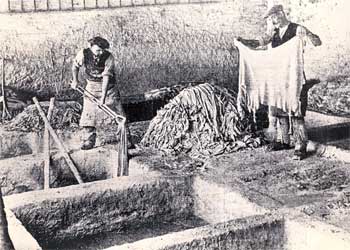



The Parish Church of St George the Martyr, Waterlooville

Steve Jones came to give us a talk and show us some pictures on the 11th April. The talk was entitled Old Industries of Havant.
Some of the industries in Havant were parchment making, glove making, butcher, brewer and cider and wine merchants.
Havant was known as “Hamafunta (the Spring of Hama), which is referring to the spring to the south-
Piped water first came in the 1870’s supplied by Portsmouth Water Company at Brockhampton Springs.
The Homewell Spring in Havant bubbles up from the ground as a small pond. The old Parchment Makers was built around it as the water was used for making paper. In the hot summer of 1976 the spring didn’t dry up, it stays 50°F all the time.
Havant was known for parchment making. Parchment was made from the skins of sheep, goats or calves. It was used as a writing material instead of paper. The skins were soaked in water, the spring in Havant gave pure water, which made a white colour parchment, which may be because of the chalk in the water. The skins were soaked for ten weeks.
A tanner takes the raw, untreated hide or skin from the abattoir and converts it into leather. In the 19th century this was done by first loosening the hair using lime and sulphide, scraping it off, then immersing in vegetable extracts. The tanner would dry the treated hide which was then in a rough preserved condition.
The fellmonger buys the sheep skins from the abattoir, removes the wool, then sells the pelt to tanners and the wool to merchants.
In 1777 there were five watermills. Havant Watermill which stood for centuries just outside the town (where Tesco now stands) was closed in 1934. In 1958 it was demolished to make way for the Havant bypass.
The Hermitage Stream runs through the town of Havant where it flows into Langstone Harbour.
Edward Stallard’s family lived in Buriton near Petersfield. His parents married in Gosport. He was employed with his father in the family trade of leather making. He died in Havant in 1869 aged 77. Later, his sons G & A Stallard opened up their business in May 1916 as Glovemakers. Alfred Stent & Sons took the business over from them and employed 100 workers. Amongst their many customers was the Queen Mother and the Queen. The glove making ended in 1960.
In 1784 there were seven inns recorded in Havant. The White Hart, The Dolphin, The Black Bear Inn, The Bell, The Star, The Black Dog and The George.
Situated to the rear of the Robin Hood Public House in Homewell Lane, the Malthouse there is first recorded under the occupancy of William Astridge, Maltster, in 1823. William Astridge died at North Hayling in 1827. He was succeeded in the Malting and Brewing business by his son Samuel. Samuel is recorded as a Brewer (retail) and Maltster in South Street.
After Samuel’s death in 1839, the business was carried on by Havant merchant David Coldwell.
Brewing in Havant reached its peak in the second and third quarters of the nineteenth century when the brewers started to take over the production of beer from the smaller maltsters and brewing became a more recognised industry.
Gloyne and Clarke began to dominate brewing in the town, and the days of the smaller maltster and the independent brewer had had its day.
The watercress beds of William Marshall were established in the 1870’s and continued until the 1960’s. Small watercress beds south of Havant are discernible on the 1797 map.
The water supplies from Havant and Bedhampton were supplied without any form of treatment, but on occasions, after heavy rainfall, the spring water became temporarily cloudy. Several improvements were instigated including the laying of a 60˝ overflow for the Hermitage stream through Bedhampton works to avoid the risk of flooding.
In 1927 a new pumping station was constructed at Havant. The old pumping station was demolished some years later.
In order to fill the Havant Thicket Winter Storage Reservoir with water, a pipeline must be constructed from the Havant and Bedhampton Springs to the reservoir site. Without the pipeline there can be no reservoir as the small water courses which drain into the reservoir site could not supply enough water to fill the reservoir.
Priscilla Barlow
Summer Edition 2013
St George’s Ladies Group
